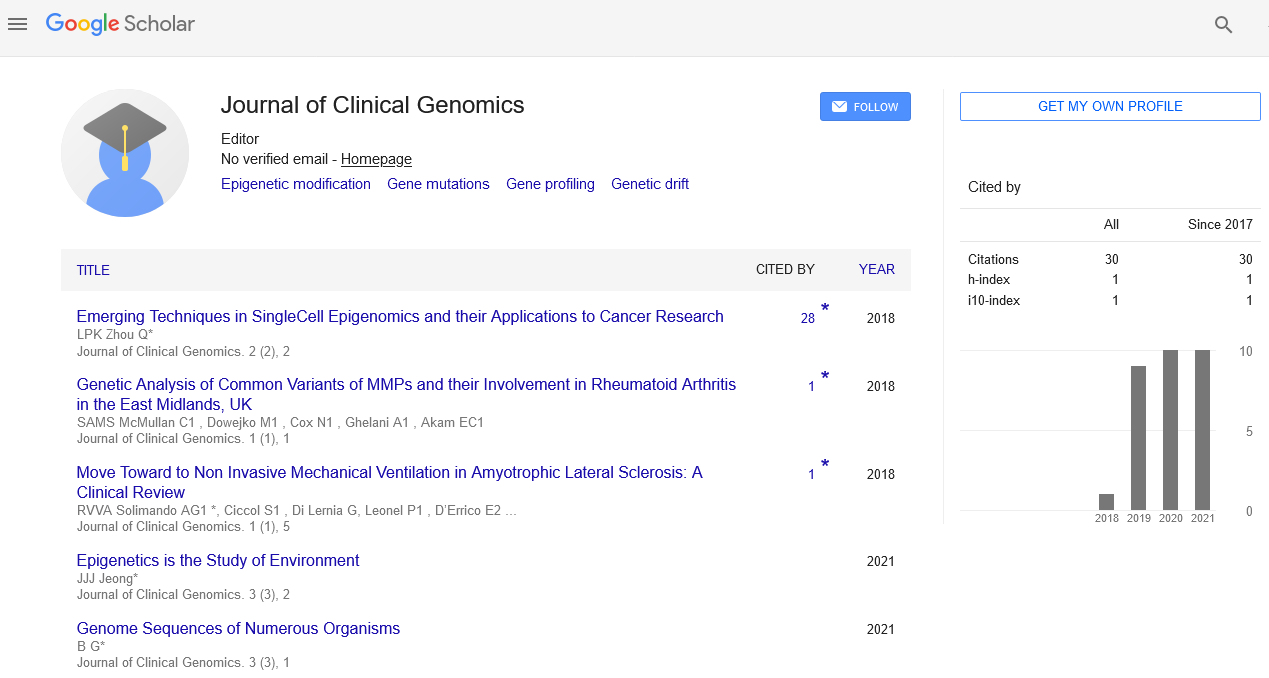Perspective, J Clin Genom Vol: 5 Issue: 4
Assessing Genetic Drift Methods and Analytical Approaches
Jennie Trevor*
1Department of Medical Biophysics, University of Toronto, Toronto, Canada
*Corresponding Author: Jennie Trevor,
Department of Medical Biophysics,
University of Toronto, Toronto, Canada
E-mail: jennie_trevor@ut11.ca
Received date: 22 November, 2023, Manuscript No. JCG-24-125696;
Editor assigned date: 24 November, 2023, PreQC No. JCG-24-125696 (PQ);
Reviewed date: 11 December, 2023, QC No. JCG-24-125696;
Revised date: 19 December, 2023, Manuscript No. JCG-24-125696 (R);
Published date: 26 December, 2023, DOI: 10.4172/JCG.1000144
Citation: Trevor J (2023) Assessing Genetic Drift Methods and Analytical Approaches. J Clin Genom 5:4.
Description
Genetic drift, a fundamental force in evolution, shapes the genetic makeup of populations over time through the random fluctuation of allele frequencies. Understanding and assessing the methods used to study genetic drift is essential for unraveling the intricate dynamics of evolutionary change. It delves into the various approaches employed to assess genetic drift, showing their significance in the field of population genetics.
Genetic drift arises from the random sampling of alleles in finite populations, leading to the fixation or loss of alleles over generations. Unlike natural selection, which is driven by advantageous traits, genetic drift's impact is more pronounced in smaller populations where chance events play a substantial role in allele frequency changes. The Wright-Fisher model provides a foundational framework for understanding genetic drift. It assumes a population of constant size, with each generation's gene pool determined by a random sample of alleles from the previous generation. Analyzing this model enables analysts to predict the probability of fixation or loss of alleles over time.
Coalescent theory traces backward in time to identify the most recent common ancestor of a set of alleles in a population. This approach allows experts to infer historical demographic events, such as population size changes and migration patterns, providing insights into the impact of genetic drift on genetic diversity. Forward simulation models involve developing computer-generated populations to simulate the evolutionary process under specific conditions. Analysts can introduce parameters like population size, mutation rates, and migration to observe how genetic drift unfolds over numerous simulated generations. These models help validate theoretical predictions and provide a bridge between theory and empirical data.
Effective Population Size (Ne) is a concept essential to understanding genetic drift in real-world populations. It accounts for factors such as fluctuations in population size, sex ratio, and reproductive variance that affect genetic diversity. Assessing Ne aids in predicting the impact of genetic drift on a population's evolutionary trajectory. The advent of molecular techniques has significantly advanced the assessment of genetic drift. Analyzing DNA sequences, microsatellites, or Single Nucleotide Polymorphisms (SNPs) allows anlaysts to directly measure allele frequencies and detect signatures of genetic drift in natural populations. Genetic bottlenecks, sudden and severe reductions in population size, are key events often associated with increased genetic drift. Statistical tests, such as the heterozygosity excess test and the M-ratio method, help identify signals of past bottlenecks by comparing observed genetic diversity with expected diversity under a stable population model.
Assessing genetic drift is vital in conservation biology to understand the genetic health of endangered populations. Monitoring allele frequencies and genetic diversity helps assess the risk of inbreeding and the potential for adaptation to changing environments. Analyzing genetic drift informs the understanding of human evolutionary history. It helps identify historical events, such as population migrations and founder effects, shaping the genetic diversity observed in different human populations. In agriculture, assessing genetic drift is vital for maintaining genetic diversity in breeding programs. Understanding the genetic drift operates allows breeders to develop strategies to prevent the loss of valuable traits.
Conclusion
As one can assess the methods and analytical approaches for studying genetic drift, it becomes evident that these tools are indispensable for unraveling the complexities of evolutionary processes. From theoretical models to empirical data, the interdisciplinary nature of genetic drift studies contributes not only to the understanding of past events but also to informed predictions about the future of populations and species. As technology advances and genetic data become more accessible, the assessment of genetic drift methods will continue to play a central role in advancing the knowledge of evolutionary dynamics.
 Spanish
Spanish  Chinese
Chinese  Russian
Russian  German
German  French
French  Japanese
Japanese  Portuguese
Portuguese  Hindi
Hindi 